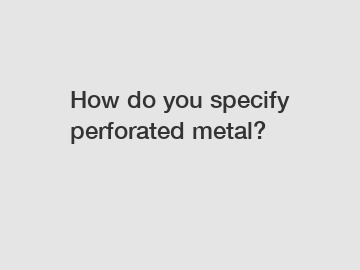How do you specify perforated metal?
In the world of construction and design, specifying the right materials is crucial to achieving desired outcomes. When it comes to adding a touch of personality, functionality, and aesthetic appeal to projects, perforated metal emerges as a highly versatile and elegant choice. However, understanding the intricacies of specifying perforated metal can be a daunting task for many. Fear not! This comprehensive guide will unravel the secrets behind this art form, empowering you to make informed decisions and maximize the potential of perforated metal.
1. Understanding Perforation Patterns:
The first step in specifying perforated metal is comprehending the various perforation patterns available. These patterns dictate the arrangement, shape, and size of the holes, determining the levels of privacy, ventilation, and visual appeal. Common patterns include round, square, slotted, hexagonal, and decorative designs. Explore the specific requirements of your project and choose a pattern that aligns with the desired functionality and style.

2. Determining Hole Size and Open Area:
The size and open area of the holes are essential factors that influence the performance and functionality of perforated metal. Measure the aperture diameter or length of slotted perforations carefully, as these measurements can significantly impact aesthetics and functionality. Moreover, consider the open area percentage, which affects airflow, visibility, and acoustic properties. Balancing the size of the holes and the open area percentage is crucial to achieving the desired balance between functionality and appearance.
3. Material Selection:
Perforated metal is available in a wide range of materials, each offering distinct advantages. Aluminum, stainless steel, brass, and copper are popular choices due to their durability, corrosion resistance, and aesthetic appeal. Consider the environmental conditions, the desired finish, and the specific application when selecting the material. Additionally, consult with experienced suppliers who can guide you on the best material for your project.
4. Choosing Gauges:
The gauge of perforated metal refers to its thickness and directly impacts its strength and durability. Generally, a lower gauge signifies a thicker and more robust material. Consider the intended application, structural requirements, and budget constraints when selecting the appropriate gauge for your project. Strike a balance between durability and weight, ensuring the installed perforated metal meets all safety standards.
5. Customization Options:
Perforated metal offers endless opportunities for creativity and personalization. To add a unique touch to your project, explore customization possibilities such as special shapes, logos, or intricate patterns. Collaborate with manufacturers who possess advanced technology and expertise to bring your vision to life. By embracing customization, your project will stand out, leaving a lasting impression on anyone who encounters it.
6. Finishes and Coatings:
Choosing the right finish or coating is vital to protect perforated metal from corrosion, enhance its aesthetic appeal, and ensure long-lasting durability. Options include powder coating, anodizing, plating, and painting, each offering different levels of protection and finishes. Consult with experts who can recommend the most suitable surface treatment for your specific application and environmental conditions.
7. Installation Considerations:
Proper installation is crucial to fully capitalize on the benefits of perforated metal. Collaborate with experienced contractors who understand the intricacies of working with perforated materials. Ensure that the chosen installation method, such as mechanical fastening or welding, aligns with the project requirements to guarantee long-term stability and maximize functionality.
Conclusion:
Specifying perforated metal requires an understanding of a vast array of factors, including patterns, hole sizes, materials, gauges, customization options, finishes, and installation considerations. By leveraging this knowledge, you can unleash the full potential of perforated metal in your projects, infusing elegance, functionality, and an unmistakable touch of creativity. Don't be afraid to dive into the world of perforated metal, as this magnificent material can truly elevate your designs to new heights.
For more information, please visit stainless steel wire mesh panels, china wire mesh, china wire mesh.
169
0
0


Comments
All Comments (0)